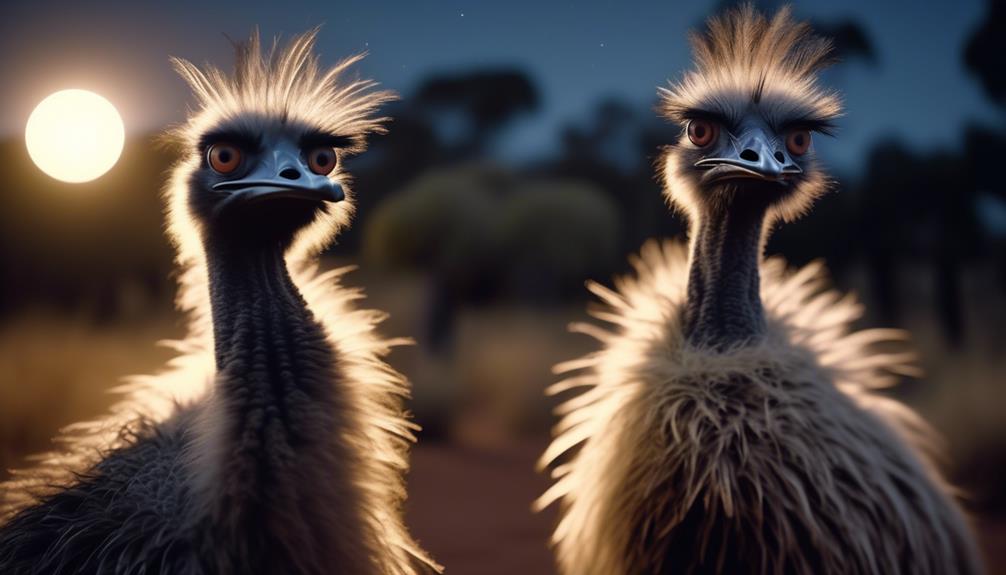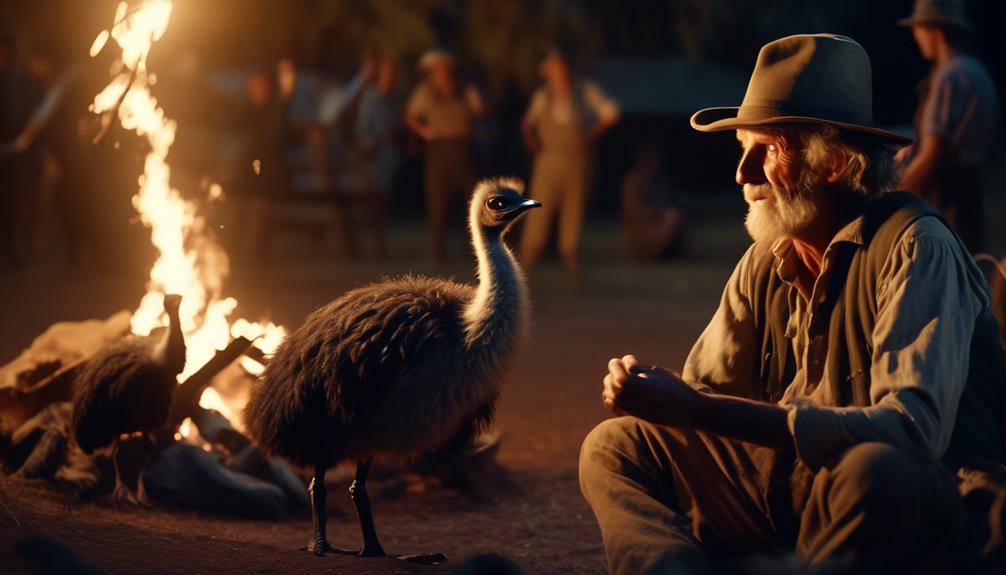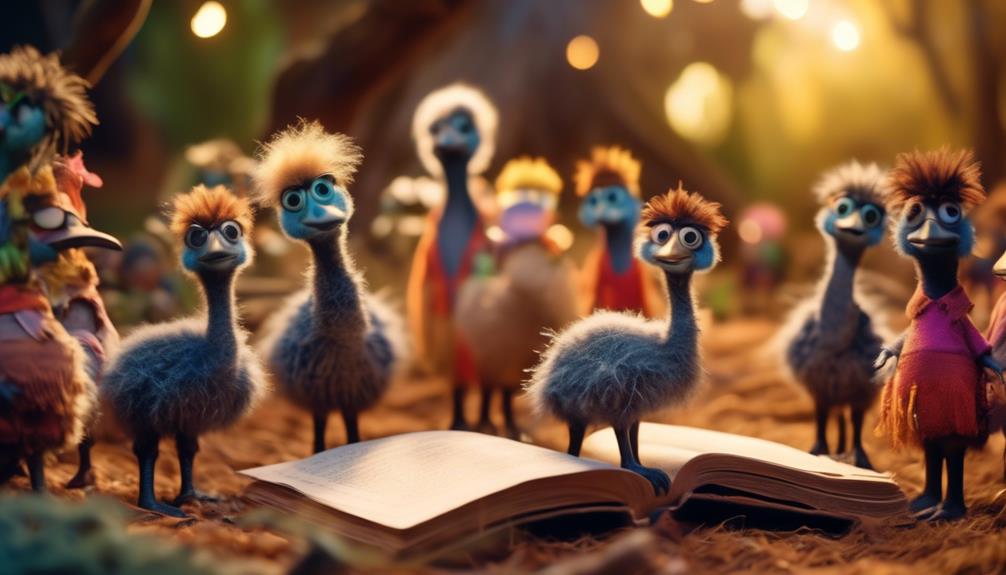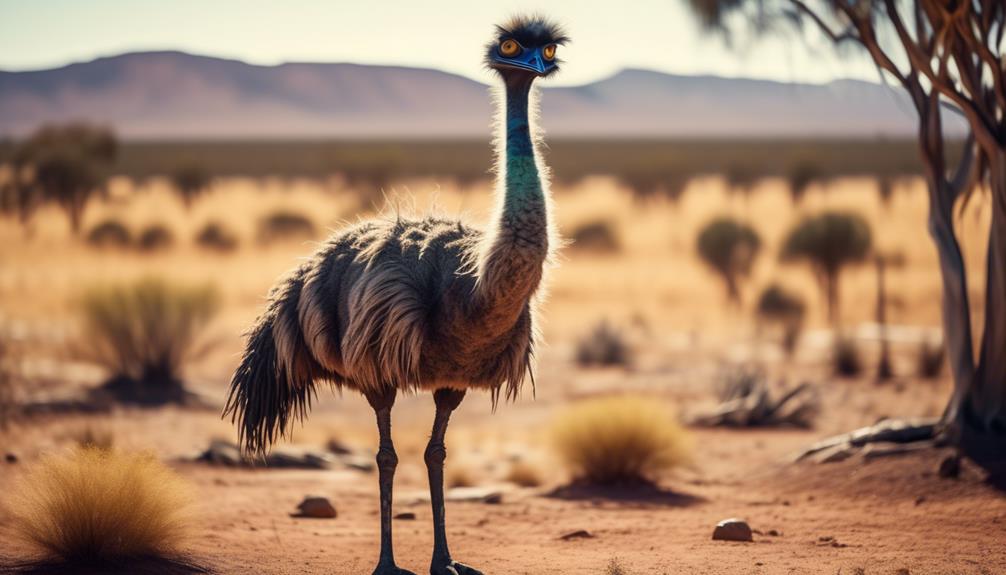
As you embark on an exploration of Australian folklore and stories, the emu stands tall, its presence looming large amidst the tales passed down through generations. Like a colorful thread woven into the tapestry of Australian culture, the emu takes on various roles, from a wise and resilient symbol to a mischievous trickster.
But what is it about these flightless birds that captivate the imaginations of storytellers and inspire the creation of children's books, nursery rhymes, and even contemporary literature? Join us as we journey through the rich landscape of emu folklore, unearthing the hidden depths and enduring significance of these enigmatic creatures.
Emus in Indigenous Dreamtime Stories

Emus play a significant role in Indigenous Dreamtime stories, weaving a rich tapestry of cultural significance and symbolism. In the Dreamtime, emus are often depicted as powerful and wise creatures, embodying important values and teachings. They're seen as guardians of knowledge, holding the secrets of creation and the origins of the land.
Emus in Indigenous Dreamtime stories represent the deep connection between the people and the land. They're often portrayed as the creators and caretakers of the natural world, embodying the spirit of the land itself. Emus are revered for their ability to navigate the vast Australian landscape, symbolizing resilience, adaptability, and survival.
These stories are passed down through generations, preserving the ancient wisdom and cultural traditions of Indigenous communities. Emus aren't only celebrated in storytelling but also in native artwork. Indigenous artists often depict emus in their creations, using intricate patterns and vibrant colors to convey the spiritual significance they hold.
The indigenous cultural significance of emus in Dreamtime stories and native artwork can't be overstated. They serve as a reminder of the deep spiritual connection between the people, the land, and the ancestral beings. Emus aren't just animals; they're sacred beings that embody the essence of Indigenous culture and spirituality.
Emus as Symbols of Wisdom and Resilience
Emus, deeply rooted in Australian culture, symbolize wisdom and resilience, embodying the enduring spirit of the land and its people. In indigenous Dreamtime stories, emus are often portrayed as spiritual guides, imparting their wisdom to those who seek it. Their ability to adapt and thrive in harsh environments is a testament to their resilience, making them powerful symbols of adaptability.
| Emus as Spiritual Guides | Emus as Symbols of Adaptability |
|---|---|
| Emus have long been revered as spiritual guides in Australian folklore. They are believed to possess ancient wisdom and are often associated with intuitive insight and guidance in times of uncertainty. | Emus are renowned for their adaptability, which is reflected in their ability to survive and thrive in diverse landscapes. Their long legs and powerful muscles enable them to traverse various terrains, from desert sands to dense forests. Emus can also go without food and water for extended periods, making them resilient in the face of adversity. |
The emu's wisdom and adaptability have become an integral part of Australian culture. They serve as reminders to embrace change and find strength in challenging situations. The emu's ability to endure and thrive in the harshest of conditions resonates with the Australian people, who have faced their fair share of hardships throughout history. Just as the emu navigates its environment with grace and resilience, so too do the people of Australia. Emus stand as symbols of hope and inspiration, reminding us to tap into our inner wisdom and adaptability when faced with life's challenges.
Emus in Settler Folklore and Colonial Tales

In the settler folklore and colonial tales of Australia, the emu emerges as a significant symbol, representing both the challenges and triumphs of the early European settlers. These stories paint a vivid picture of the encounters between settlers and emus, highlighting the emu's strength, adaptability, and resourcefulness in the harsh Australian landscape.
In one tale, a settler recounts the awe-inspiring sight of a large emu flock, their long legs propelling them effortlessly across the vast, arid plains.
Another story tells of a settler's struggle to protect their crops from the hungry emus, cunningly outsmarting them by erecting makeshift fences and scarecrows.
Settler folklore also speaks of the emu's elusive nature, with tales of emus disappearing into the thick bush, leaving settlers in awe of their ability to blend seamlessly into their surroundings.
Colonial tales often depict emus as a symbol of resilience, as settlers face the daunting challenge of taming the land and building a new life in a foreign environment.
These tales also explore the complex relationship between settlers and emus, highlighting the settler's simultaneous admiration for the emu's endurance and their need to conquer and control their new home.
In settler folklore and colonial tales, emus become both an emblem of the Australian landscape and a reflection of the settlers' struggles and triumphs. Through these stories, the emu encapsulates the spirit of resilience and adaptability that defined the early European settlers in Australia.
Emus as Tricksters in Australian Folktales
Tricksters in Australian folktales, emus play a mischievous role, weaving their clever schemes and outwitting unsuspecting characters. In these stories, emus are portrayed as cunning and intelligent creatures, using their wit and agility to outsmart others. However, their tricks aren't solely for personal gain. Emus are often depicted as guardians of the land, using their cleverness to protect their home and ensure the survival of their species.
In Australian folklore, emus are seen as teachers of survival skills. They possess a deep knowledge of the land and its resources, and they impart this wisdom to those who are willing to learn. Through their tricks and pranks, emus teach important lessons about adaptability, resourcefulness, and resilience. Their stories serve as allegories for navigating the challenges of life, reminding listeners of the importance of quick thinking and innovation in the face of adversity.
Emus as tricksters also reflect the cultural significance of these birds in Australian society. Known for their agility and speed, emus have long been admired by Aboriginal communities. Their ability to outwit others is seen as a form of intelligence and a testament to their survival skills. The tales of emus as tricksters not only entertain but also celebrate the ingenuity and resourcefulness of these remarkable creatures, reinforcing their status as revered figures in Australian folklore.
Emus in Children's Books and Nursery Rhymes

Children's books and nursery rhymes in Australia often feature the enchanting presence of emus, captivating young readers with their unique charm and cultural significance. Emus, with their distinctive appearance and lively personalities, have become beloved characters in modern day Australian art and animated films.
In these children's books, emus are often depicted as curious and adventurous creatures, embarking on exciting journeys through the Australian outback.
Emus are portrayed as friendly and helpful companions to the main characters, teaching them important lessons about friendship, perseverance, and the wonders of nature.
The illustrations in these books showcase the emus' long legs and fluffy feathers, capturing their elegance and grace as they gracefully traverse the vast landscapes.
Emus are often depicted in vibrant and vivid colors, reflecting the rich diversity of Australia's natural environment and highlighting their role as symbols of the country's unique wildlife.
Nursery rhymes featuring emus often incorporate playful and rhythmic language, engaging young readers with catchy tunes and memorable verses that celebrate the emus' quirky behavior and joyful spirit.
Through these children's books and nursery rhymes, emus have become cultural icons, instilling in young readers a sense of wonder and appreciation for the natural world around them. Their presence in modern day Australian art and animated films further solidifies their status as beloved characters that continue to captivate audiences of all ages.
Emus in Contemporary Australian Literature
With their enduring presence in children's books and nursery rhymes, emus have also found their place in contemporary Australian literature, enriching the cultural landscape with their symbolic significance and captivating narratives.
Emus in contemporary poetry evoke a sense of connection to the Australian land and its unique wildlife. In poems like 'Emu Dreaming' by Judith Wright, the emu becomes a powerful symbol of the Australian identity, representing resilience, freedom, and the untamed spirit of the land. Through vivid descriptions and lyrical language, these poems transport readers to the vast, untamed landscapes where emus roam.
Similarly, emus appear in Australian environmental writing, where they symbolize the delicate balance between human civilization and the natural world. In works like 'The Emu's Call' by Bruce Pascoe, emus serve as a reminder of the ecological interconnectedness of all living beings. The emu's call becomes a call to action, urging readers to protect and preserve the fragile ecosystems that sustain life.
Through their portrayal in contemporary Australian literature, emus offer readers a deeper understanding of the country's cultural and environmental heritage. They embody the spirit of the land and serve as powerful metaphors for the challenges and triumphs faced by both humans and nature. In their narratives, emus carry the weight of history, culture, and the ongoing struggle to harmonize with the natural world.
Emus in Popular Culture and Media

Emus have become prominent figures in popular culture and media, captivating audiences with their unique appearance and intriguing behaviors. These fascinating birds have found their way into various forms of expression, from music to art, adding a distinct Australian touch to the creative world.
- Emus in Australian music: In the realm of music, emus have inspired numerous songs that celebrate the spirit of the Australian outback. Their majestic presence is often invoked in lyrics and melodies that capture the essence of the country's vast landscapes and the adventures that unfold within them.
- Emus in Australian art: Artists have long been fascinated by the emu's graceful form and enigmatic demeanor. This has led to the inclusion of emus in many Australian artworks, both traditional and contemporary. Paintings, sculptures, and other art forms often depict emus as symbols of resilience, freedom, and the untamed beauty of the Australian wilderness.
- Emus as cultural icons: Emus have become iconic symbols of Australian culture, representing the unique and diverse wildlife that inhabits the continent. Their inclusion in popular culture and media serves to showcase Australia's natural heritage and foster a sense of national pride.
- Emus as mascots: Emus have also found their way into the realm of sports and entertainment as mascots for various teams and events. Their distinctive appearance and connection to Australian identity make them fitting representatives for these occasions, adding a touch of whimsy to the proceedings.
- Emus in storytelling: Emus have been featured in numerous books, films, and television shows, where they often serve as characters that embody the spirit of the Australian bush. Whether portrayed as wise guides or mischievous tricksters, emus bring a sense of authenticity and cultural richness to these narratives.
Frequently Asked Questions
What Is the Scientific Classification of Emus?
The scientific classification of emus is as follows: Kingdom Animalia, Phylum Chordata, Class Aves, Order Casuariiformes, Family Dromaiidae, Genus Dromaius, Species D. novaehollandiae. Emus are known for their tall stature, flightless nature, and curious behavior.
How Fast Can Emus Run?
You won't believe how fast emus can run! These majestic birds can reach speeds up to 30 miles per hour. Their speed is a testament to their resilience and determination, just like their role in Australian folklore and stories.
Are Emus Considered Endangered Species?
Emus, not considered endangered, play a significant role in Australian culture. As national symbols, they represent resilience and freedom. Emu farming also contributes to the economy, providing opportunities for employment and exportation of emu products.
Are There Any Specific Emu Festivals or Events in Australia?
Yes, there are specific emu festivals and events in Australia. These events celebrate the emu's significance in Aboriginal culture and raise awareness about emu conservation efforts. They provide a unique opportunity to immerse yourself in the rich cultural heritage of Australia.
Do Emus Have Any Natural Predators in Australia?
Emus, with no natural predators, have thrived in Australia, resulting in a large population. This has led to concerns about emus' impact on Australian ecosystems, prompting measures for population control.
Conclusion
As you delve into the rich tapestry of Australian folklore and stories, it becomes undeniable that emus have played a significant role.
Indigenous Dreamtime stories depict them as sacred beings, embodying wisdom and resilience. In settler folklore, they're seen as symbols of the harshness of the land and the challenges faced by early colonizers. Emus also take on the mischievous role of tricksters in Australian folktales.
From children's books to contemporary literature, emus continue to captivate readers, bridging the gap between culture and imagination. In popular culture and media, they remain an enduring symbol of Australia's unique heritage.




